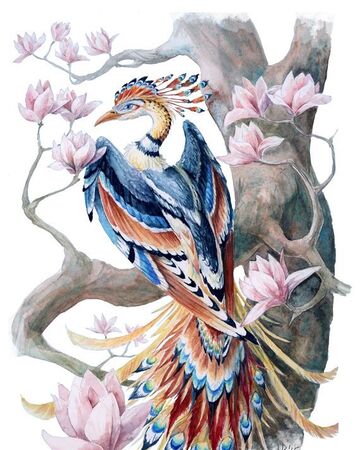
The Phoenix in classical mythology is a fabulous bird associated with the worship of the sun. It is known for its cyclical regeneration. The phoenix obtained new life from the ashes of its predecessor.
But where did this firey creature come from?

The phoenix can be traced back to ancient Egypt. The Egyptian phoenix was said to be the size of an eagle, with brilliant scarlet and gold plumage and a melodious cry. Only one phoenix existed, as it continued to be born again. As it approached the end of its life, the phoenix fashioned a nest of boughs and spices, set it on fire, and was consumed in the flames. From the pyre, spang the new creature which flew to Heliopolis- the City of the Sun – to the temple of the sun god Re.
The Egyptians associated the phoenix with immortality, and that symbolism had a widespread appeal. It was adopted into other religions, including Islam and Christianity.

In Christianity, the phoenix was compared to undying Rome, and it appeared on the coins as a symbol of the Eternal City. It was also interpreted as an allegory of the resurrection.
In Islamic stories, the phoenix was identified as the “anqā,” a mysterious bird that was originally created by God with all perfections, but thereafter became a plague and was killed.
It is in these stories that we start to see where the stories of the phoenix were inspired.

The word “anqā” is the feminine form of ʾaʿnaq meaning “long-necked. This implies the animal had a long neck such as a heron or crane.
The anqā was described as very beautiful and colorful with a long neck and four pairs of wings. It was also known for the whiteness in its neck. It is said the animal eats nothing except elephants and large fish.


It is likely the phoenix is based on a combination of the Goliath Heron and the Grey Heron. Both animals are native throughout Europe and Asia and into parts of Africa. Birds of the wetlands, they can be seen mainly around lakes, rivers, ponds, and on the sea coast. They feed on aquatic animals, such as fish and frogs.
The Goliath Heron, also known as the giant heron, is the world’s largest living heron. This animal stands 1.5 meters and weighs up to 5 kg. The animal is covered mainly in grey feathers. The head and chest are chestnut. The chin, throat, foreneck, and upper-breast are white with black streaking.
The Grey Heron stands up to a meter tall and weighs up to 2 kgs. They have a white head and neck with a broad black strike extending above the eye into a feathered crest. The body and wings are blue-grey with black underneath. The beak is a sharp pink.

In Egyptian tradition, herons were considered a manifestation of the resurrected Osiris. The bird is often shown perched in his sacred willow tree. The heron hieroglyph was used to Re directly. It has always had close ties to the sun.
The heron was also closely associated with Nile and the creation. It was often seen on isolated rocks of the islands and the chaos that flooding could cause. This association could be where Islamic tradition associated the phoenix with plague.
The word phoenix originates from the Greek word phoinīx. The word was borrowed from the West Semitic word for madder, a red dye made from the rubia plant. The word Phoenician (modern day Lebanon) appeared to be from the same root, meaning “those who work with red dies.” Therefore, it is believed that phoenix means “The Pheonician bird” or “The red bird.”

The legend of the phoenix has gone through several iterations as it passed through several cultures. It started out as herons in the Egyptian culture symbolically representing rebirth and the sun god Re. As it has moved to modern culture, we lost the original source turning them into mythical creatures born from flames.
Sources:
Van der Broek, R (1972), The Myth of the Phoenix.
Barnhart, Robert K (1995), The Barnhart Concise Dictionary of Etymology, HarperCollins.
“Grey heron (Ardea cinerea)”. ARKive.
Ali, S. (1993). The Book of Indian Birds. Bombay: Bombay Natural History Society.
“Phoenix (mythological bird)”. Encyclopedia Britannica.
Cirlot, J. E. (2013). A Dictionary of Symbols. Courier Corporation.